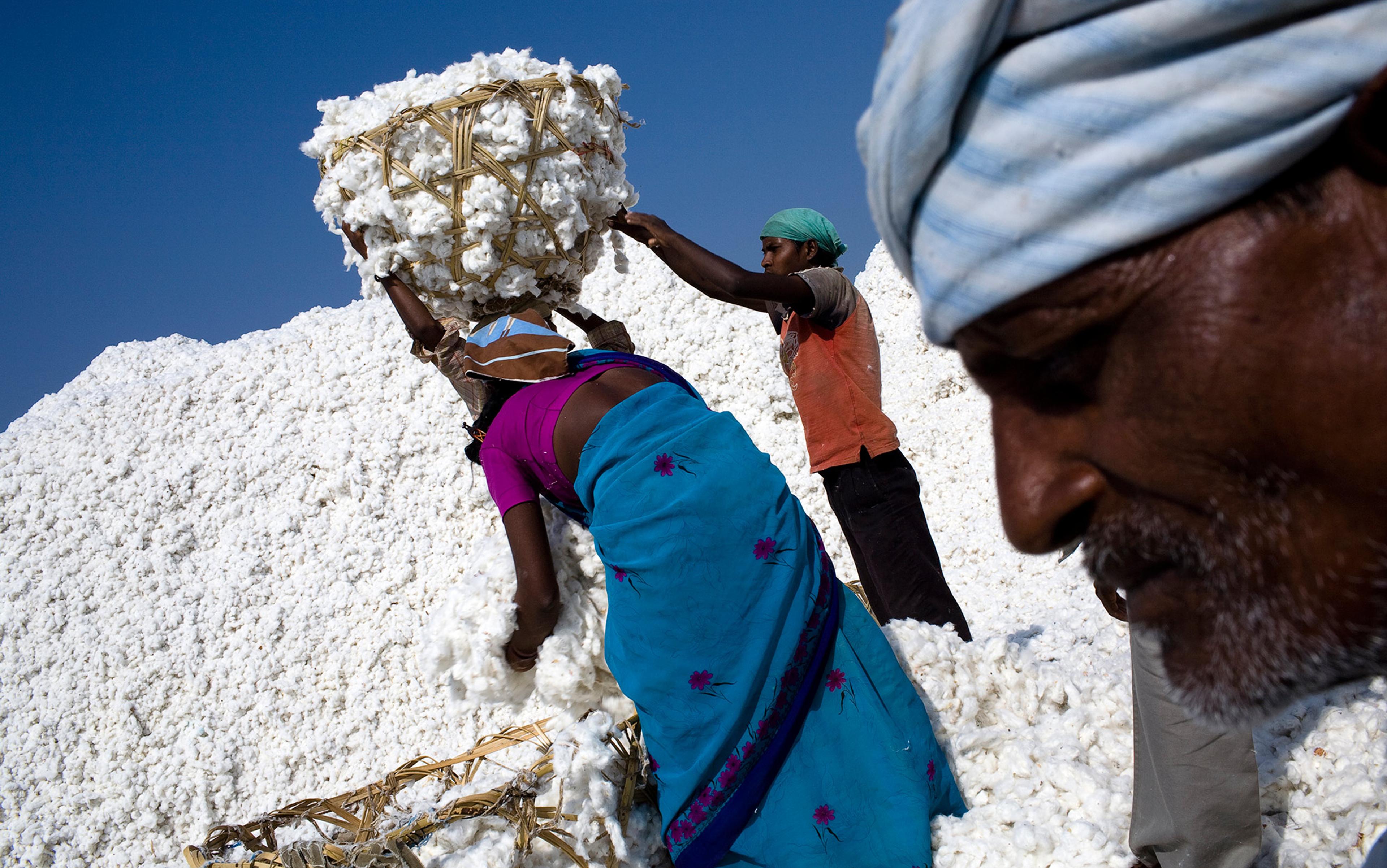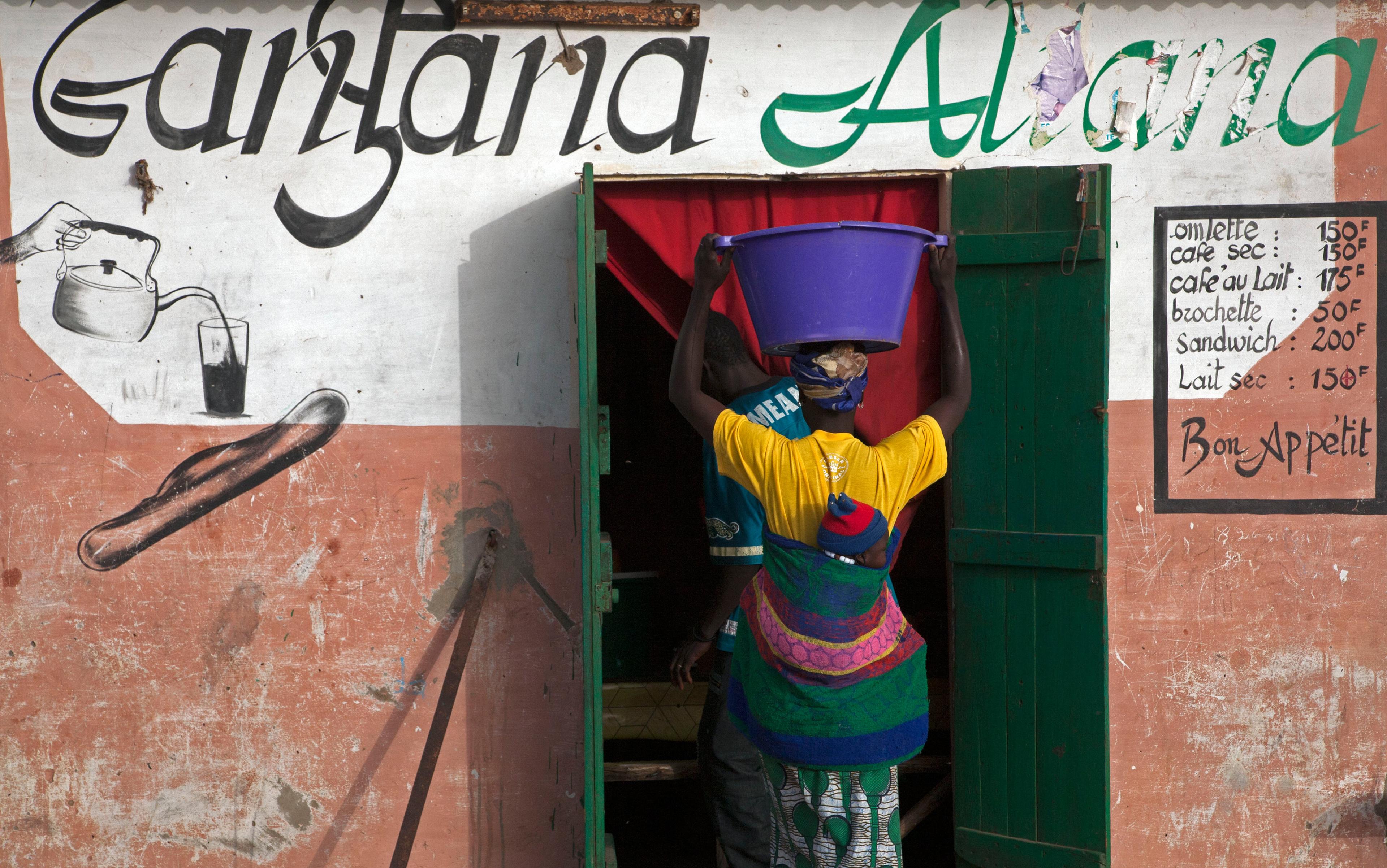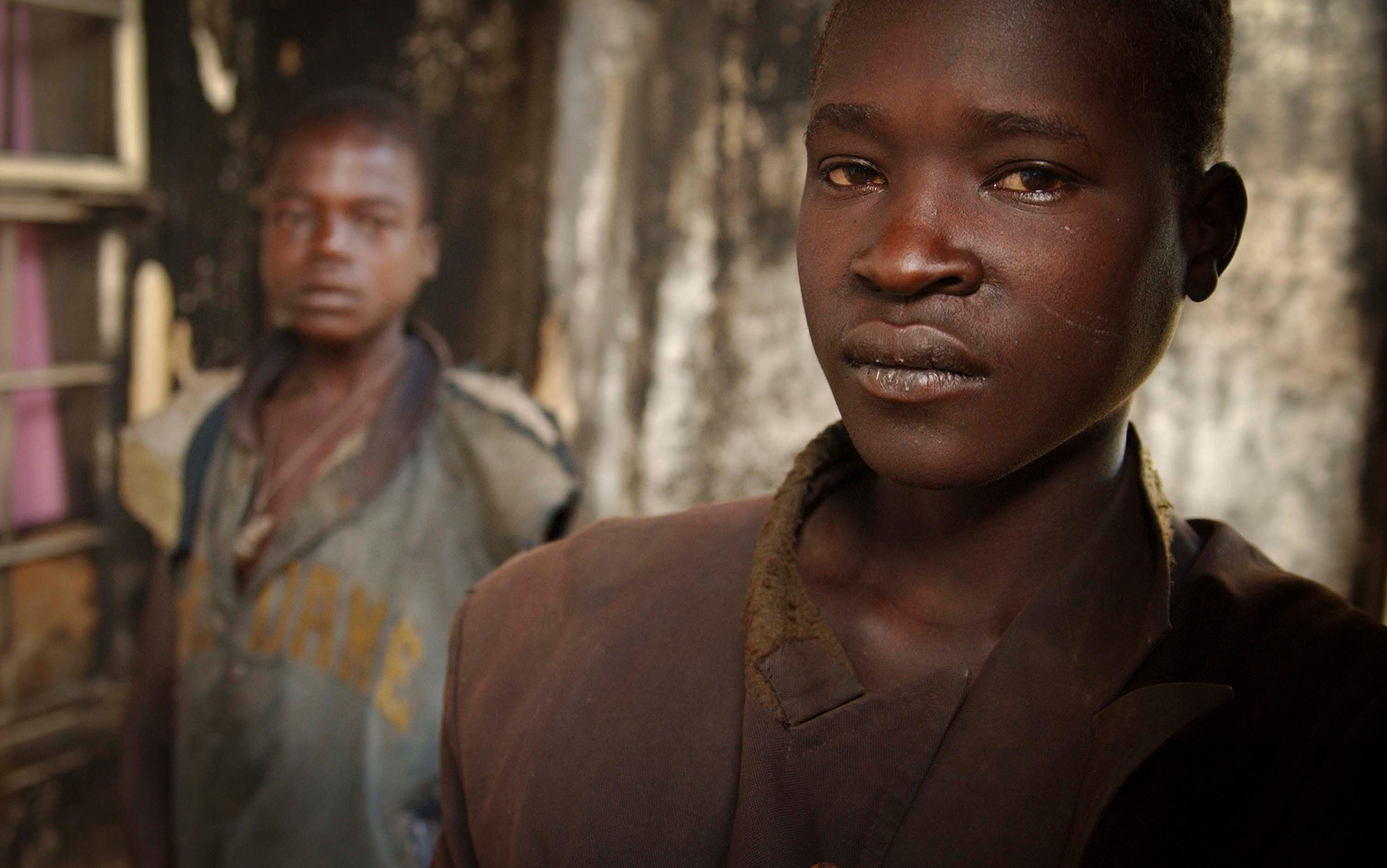I liked Aanan as soon as I met him. My field notes read: ‘What a nice guy, you can just see from his face.’ Open-faced and conversational, he was enthusiastic about the explosive growth in his quarry operations and excited to show me around. Together, we toured the open mines where his workers carve into the earth, producing boulders that are broken down into gravel by smaller labourers, often women and children. Together with his workers, Aanan laughed at my efforts to repeat the process for myself, the sledge held high over my head before arcing down, momentarily disappearing into shards and dust.
He showed me the crushing equipment that transformed gravel into silica powder, proudly explaining that the Indian multinational company, Tata, which makes generous donations to Harvard’s renowned business school, was the exclusive buyer of his materials. I had met Aanan through a friend of his, a reference that considerably eased his concerns about speaking with an outsider regarding his operations. The fact that I was most interested in challenging bonded labour – a contemporary form of slavery – didn’t matter.
Around half of the world’s slaves are held in debt bondage in India, Pakistan and Bangladesh. Debt bondage is a very old form of slavery in which radically marginalised members of society, often from India’s ‘untouchable’ caste, must trade all their labour for single small infusions of cash. Broader social and economic systems ensure that they do not understand the terms of such loans, and that the time required to repay them is interminable. Lack of other work, lack of credit, and the need to pay for schooling and marriages effectively guarantee that there is no single contractual debt between the landlord and labourer but rather a string of interconnected informal loans.
Workers are often promised that their debt will be repaid within a certain period of time, only to be told that they have somehow incurred new debts. Running debts are occasionally sold to other slaveholders, and in this way a worker can change hands several times. Local officials are more likely to turn a blind eye than to enforce a remote law.
The days of owning people are over, yet slavery still persists in dark pockets of the global economy. All forms of slavery are now illegal in every country on Earth, yet the practice still festers in unreformed nests of feudalism, where threats and violence can suppress or eliminate pay for work. Where slavery is verboten, psychological control through deception and fear is the new coin of the realm. In the case of debt bondage, it is the caste system – with Brahmin at the head and ‘untouchable’ beneath – that does the delicate work of stitching debts together into a seamless, infinite coercive system that leaves labourers feeling trapped.
Despite the abuse, the caste-based worldview frames these exploitative labour relations in familial terms. ‘You have to understand the mentality of labourers, and you should know how to make them work,’ says Aanan, who views himself as the caring parent and his workers as children. ‘To manage a group of labourers is like managing a group of primary-school children. They have to be provided with food or clothes, and they are taught how to behave … sometimes they start drinking alcohol; sometimes they indulge in feasts. So we have to pay them with caution. We divide them into small groups because larger numbers of workers tend to form a union and sometimes engage in mass holidays or strikes.’
Aanan says the happiness of his worker is paramount, even though his business model depends on entrapping the vulnerable and working them to the bone as they crush rock from dusk to dawn. He couldn’t come out and say this to me or to his workers – or perhaps even to himself.
Withholding pay and limiting opportunities to mobilise are important strategies for controlling workers. But all of this is done for the workers’ own good, Aanan insists. Though landlords complain about alcohol, such indulgences are also tactics for increasing debt. Rowdy festivals allow workers to blow off steam, effectively directing frustration away from their abusers. These events also allow workers to spend what little money they have, increasing the likelihood that they will remain dependent on the landlord’s line of credit.
To the erstwhile slaveholder, leisure activities – talking, idling, drinking – are vices, tangible manifestations of social decline
When asked if he needs the workers or the workers need him, Aanan explains that: ‘The worker is my cash machine, my fate.’ In this one statement, he has captured a central contradiction inherent in most human-rights violations worldwide: exploitation takes place at the intersection of culture and capital, in the overlap between relationship and extraction, at the moment where care and exploitation intersect.
Long accustomed to power, slaveholders work hard to sustain their status and baulk at any hint of equality. One previously powerful employer confided to me that his community was in decline. ‘In the olden days … labourers used to work in their fields, they used to think of their work,’ he told me. Now, however, they freshen up after work and drink coffee and tea while talking about ‘unnecessary things’, an opportunity for democratic discourse that is ‘deviating their minds’.
The public square is celebrated by scholars of democracy as a pillar of free and open society. But to slaveholders this space is a cauldron of ‘enmity, ego, and hatred’. Free workers spending their free time talking about life is what gives democracy its vitality – no wonder it’s perceived to be a threat to those who have benefitted from the caste hierarchy. To the erstwhile slaveholder, leisure activities – talking, idling, drinking – are vices, tangible manifestations of social decline.
For Brahmins such as Aanan, who don’t tend to drink, this stance of purity and power shrouds the larger tactical terrain in a mist of paternalistic pressure and concern. ‘Like a shepherd who knows his herd like the back of his hand, we know the labourers,’ he confides. ‘It’s like understanding psychology. Anyone can become a contractor, but a good contractor can gauge the mood of the workers and then make them work … Thus, little by little, with caution, we claim back our money. It is the emotional pressure that works.’ A key strategy for Aanan is keeping workers indebted while asking for their gratitude and undermining their perception that opportunities exist.
In a form of Stockholm syndrome, the oppressed often agree. In multiple conversations, I have been told by bonded labourers that they genuinely owe a debt – some having worked for years to repay an amount that would have taken 10 days of work at prevailing wages. Maintaining this sense of obligation requires emotional pressure at a moment of economic vulnerability – say, when a grateful parent is advanced medicine money for a sick child. Bonded labour requires an actual relationship in which the perpetrator is keenly aware of what kind of pressure – threats? violence? promises? – will ensure compliant work, despite abusive conditions and a lack of pay.
While not every one of the slaveholders I spoke with in the course of this research was as frank as Aanan, his approach bears all the traits of contemporary slaveholding: financial distress, emotional manipulation, illegality, and paternalism. At the end of our conversation, I inquired about Aanan with one of my research partners. Yes, they had heard of him. I updated my field notes: ‘Largest contractor in [town].’
When most people think of contemporary slavery, the popular imagination leaps to a desperate brothel, one pulled straight from the pages of a newspaper or an activist brochure. The scene is sordid: the victim – pure, and the perpetrator of this human-rights violation – an animal of the worst sort. Reality is nowhere near this simple. Contemporary slaveholders, like contemporary slavery, come in many forms. And these men have other terms for their socioeconomic roles and relationships, including ‘employer’, ‘boss’, ‘landlord’, ‘farmer’, ‘contractor’, ‘master’, and ‘landowner’.
Ahmed, a middle-class slaveholder in Uttar Pradesh in India, was eager to show me around the village where he was a member of the ruling elite. While I was grateful for the warm reception, I was visiting Ahmed’s community because of gross human-rights violations – bonded labour, child exploitation, and outbound human trafficking. Fathers pleaded for help in finding missing children, long gone, lured away by the promises of traffickers. Mothers who had recently and reluctantly formed a fragile women’s group waited nervously to meet and discuss their progress in negotiating higher wages. Behind the weeping men and the expectant mothers sat the children lucky enough to remain in the community, hand-rolling local cigarettes.
These scenes are common throughout rural India and are repeated across the global South, where the intertwined pressures of poverty and hope have been more likely to terminate in rights violations than a better life. Individuals exploited in slavery deserve safer lives, smarter laws and greater opportunities. There is a near-global consensus about victims’ needs. But who are the perpetrators? Do Aanan and Ahmed not see the scene – debt bondage, child labour, trafficking – as blatantly wrong?
As a sociologist, my work focuses on a few straightforward questions: where does social change come from? How do people mobilise for change? When does it work and why? Like my fellow travellers in the social sciences, I’m motivated by pressing social issues – poverty, inequality, violence.
Since the 1960s, telling the story of the powerless has seemed like our full-time job. The social historian E P Thompson in The Making of the English Working Class (1963) was explicit in this regard: ‘I am seeking to rescue the poor stockinger, the Luddite cropper, the “obsolete” hand-loom weaver, the “utopian” artisan, and even the deluded follower of Joanna Southcott, from the enormous condescension of posterity.’
The humanities and social sciences have spent the past few decades following suite. My fellow scholars of protest movements have rigorously catalogued critical struggles for civil rights, women’s rights, and the environment, as well as against wars and against colonial rulers. A sustained commitment to telling the stories of the powerless has increased our understanding of a previously silenced majority of downtrodden and oppressed people. But it has also narrowed our view of the oppressors.
It’s only now that we are waking up to ask new questions about Right-wing movements such as the Ku Klux Klan and Al-Qaeda. A fresh generation of scholars are writing books about the Tea Party and those who protest on behalf of the rich, such as Isaac Martin’s Rich People’s Movements (2013). In conversations with rights-violators such as Aanan, I heard the same thing again and again: ‘You’re the first person to ask me about my life.’ Attention to slavery and trafficking has grown exponentially in the past decade, but interviews with rights-violators are exceptions to the rule. To understand the story of exploitation, we must talk to exploiters, too.
I’ve tried to fill this gap. I got my start in the anti-slavery movement in the late 1990s in India as a representative for an advocacy group. In my first assignment, I posed as a customer in a brothel while capturing clandestine footage to help break a case against traffickers into the sex industry. In my assigned role, I demanded younger and younger girls, and then stormed out when the ‘goods’ didn’t meet my expectations. The footage was reviewed by a team of lawyers, forensics experts, and sometimes the police to determine whether a rescue operation could result in an actionable case. There was no use conducting a raid only for the case to fall apart, the perpetrator to go free, and the victim to slip through the cracks of a broken system, and then a month later show up again on our tape.
Yet over a decade of such work, I couldn’t shake the feeling that locking up perpetrators was the bluntest of instruments. Wealthy slaveholders simply bribed their way out of court while poorer perpetrators got caught in the system. Perhaps the term slaveholder brings to mind a wealthy plantation-owner, and the term trafficker summons the image of a terribly violent pimp – in reality, many perpetrators are small-time operators, no matter the name. In my research, I came across a slaveholder who was surviving with help from a bonded labourer and loans from the Grameen Bank, a Nobel Peace Prize-winning microfinance organisation dedicated to extending loans to the world’s poor. He was more powerful than his slaves, but not by much.
Goral paid his bonded labourer about $10 a year for two years, and then convinced him to continue working for three more years without pay
What an insight my boots on the ground revealed. In my talks with powerful-looking but powerless-feeling people, I discovered the power of nostalgia. We long for the past, which we remember with warmth, and we will do almost anything to keep what we have and grasp for what we have lost. This is as true in rural India, where the caste system is remembered with nostalgia, as it is in Indiana, where an industrial era is remembered wistfully, despite a history of racial exclusion. In times of cultural, political or economic upheaval, rights-violators are often trapped between the awesomely powerful and the completely powerless. What do we know of people who might once have possessed great power, but who are now in decline?
Across the Indian states of Bihar, Uttar Pradesh and Karnataka, and in 16 different communities, I sat down to speak with slaveholders. If you talk to rights-violators for long enough, they’ll tell you about their life. In interview after interview, these men – and they were all men – expressed a sense of loss. Each had been challenged by local efforts to end bonded labour in their community. Each yearned for the old days, when ‘we were like family’, and each member of the community knew his or her place.
When I asked Goral, an older man whose bonded labourer no longer worked for him, whether there had been any change in relationships between bonded labourers and masters, he replied: ‘There is no such change. We are like family.’ He explained that the labourer came to them as a child in order to repay a debt assumed by the boy’s father in a nearby village. Over time, Goral obtained the debt and the boy along with it. When I asked how their relationship began, he explained: ‘There was debt – that is why we kept him as a bonded labourer! After repaying the debt, he also worked as a bonded labourer for a few more years. His debt was 1,000 rupees [around $20] and he worked for four or five years. He remained with me because I had a shortage of labour, and the bonded labourer had some problems at home, so I requested that he continue for a few more years.’ In other words, Goral paid his bonded labourer about $10 a year for two years, and then convinced him to continue working for three more years without pay.
Goral was proud of the extent to which he had been able to care for this boy as he grew into a young man. The fact that the boy worked for years to pay off a $20 debt obscures the deeper social reality, which is that Goral cared for someone who had problems at home. This win-win was, in Goral’s retelling, an ideal form of mutual aid. It is what family does.
The familial model allows for the presence of a patriarch, a role that interviewees referenced consistently. I was told that, in better times, slaveholders’ fathers had ruled with fear and respect. Across these conversations, the paternalistic lines were easy to trace; respect was expected in exchange for care: ‘We served the people. If someone was lacking something, we would give it to them. It’s like that; we helped them.’ Labourers, in this nostalgic reckoning, were hard-working, grateful and honest. They held up their end of the cosmic bargain so central to caste, and benefited in turn.
Such were the olden days for slaveholders. The present, by contrast, is a time of loss and decline. As one high-caste slaveholder explained to me: ‘To be born in the higher caste has become a bane. Even when we do well, we are blamed and our rights are withheld.’
This problem is bound up in broader social change that slaveholders, in the agricultural sector especially, are ill-equipped to manage. New roads are built, new laws are passed, and new ideas spread. They face substantial changes in the form of rapid urbanisation and migration, the collapse of commodity prices, conditions of persistent drought, the disappearance of party allies, the diminished value of caste, and an uptick in challenges from the poor and marginalised. For many rural slaveholders, their surest resource is their caste status, yet rhetorical threats such as ‘Don’t you know who I am?’ ring hollow when mobile phones deliver news about better jobs in growing cities connected by bigger roads. Traditional authority is a depreciating asset for many slaveholders faced with broader social and economic change. Workers are voting with their feet.
Broad trends and local activism don’t stop the powerful from doing their best to hold on to power. In many cases, slaveholders’ first response would be to lash out – threatening, beating and occasionally killing uppity workers. But persisting this way is costly, especially when the landlord’s authority is undermined by globalisation’s siren call.
Better informed about what their labour is worth on the free market, workers now have a sharper understanding of what kind of employment opportunities exist in nearby cities. Landlords feel their grip loosening; wanting to act decisively, they find themselves fumbling. They fume and curse, but often they have to give up and learn to live in the new world.
They’d rather continue benefiting from the exploitative status quo, but recognise that the political and economic winds are not at their backs. Worldwide, there are new laws to protect workers, and there’s increased attention to bonded labour and human trafficking. India has seen a shift from the caste economy to the cash and credit economy, and there is no turning back. In the face of these changes, some rural slaveholders have given up.
But does a decision to stop exploiting others signal a change of heart, or are slaveholders biding their time? Slavery makes money for those who practise it, and that money adds up. For anti-slavery activists, the message is clear. Contemporary abolitionists must approach perpetrators such as Aanan with tactics that reflect the changing reality, so that motives for exploitation can disappear.
Slaveholders should be held to account, but also enfranchised to enter the modern world. After all, as my own research revealed, they are rarely monsters. The journalist John Conroy, in his book Unspeakable Acts, Ordinary People (2000), reflected on his handful of interviews with torturers only to confess that ‘some part of me hopes that the men I have interviewed are not representative of the whole, because for several of these men, I have a certain respect [for their willingness to speak candidly]’. Even more complicated, it seems, is the feeling that ‘in a few I could see myself.’
Likewise, many of the men I interviewed had children the same age as my own, and others struck me as the classic beneficiaries of the kind of international development programmes that I tend to support. In interview after interview, I came away with the same sense as Conroy: ‘The worst part of these interviews was that they were not difficult … I never met the monster I anticipated.’
Siddharth Kara – a fellow at Harvard’s Carr Center on Human Rights and the author of two important books, Sex Trafficking (2009) and Bonded Labor (2012) – found the same thing in conversation with a trafficker: ‘He was so ordinary – just a man, wearing simple village clothes. His aspect was common, his moustache trimmed, his hair neatly combed.’
No wonder we fail to recognise the villain.
Human-rights violators are a far cry from John Rawls’s evil, bad and unjust men. ‘What moves the evil man is the love of injustice,’ Rawls wrote in A Theory of Justice (1971), ‘he delights in the impotence and humiliation of those subject to him and relishes being recognised by them as the wilful author of their degradation.’
The sun was setting on the slaverholders’ way of life and, in their own minds, they play the leading roles as victims and heroes in turn
The contemporary traffickers and slaveholders I spoke with are not motivated by a love of injustice. They are instead driven by cultural inertia, a desire for profit or, more frequently, a need for basic sustenance. Instead of evil villains, we find husbands, fathers, mothers and neighbours working with the cultural materials available to them, surviving as best they can.
The terms used here – slavery and slaveholder – never crossed the lips, nor perhaps even the minds, of the men I spoke with. As we broke bread, drank tea, explored plantations and silk-production houses, swam in deep wells, climbed coconut trees and talked late into countless evenings, the term slavery never came up. What came up, time after time, was respect, honour and dignity. The sun was setting on their way of life and, in their own minds, they play the leading roles as victims and heroes in turn.
In so many ways, we all find ourselves at this juncture: in the interregnum between generations, eras and epochs. Tremendous changes have provided new opportunities for marginalised people, while the formerly powerful find themselves suddenly in possession of a form of power – caste and land – that lacks much exchange value in the new world.
For the recently powerful, this transition can be devastating and demoralising. What psychologists call loss aversion is real; humans don’t want to lose what we have, no matter what.
This is true whether the loss is occurring in Birmingham, Alabama – or Bihar, India. The real question is how we respond to loss – by lashing out, by learning, by opening up, or by closing down. Surely Aleksandr Solzhenitsyn was right when he wrote in the The Gulag Archipelago (1973): ‘If only it were all so simple! If only there were evil people somewhere insidiously committing evil deeds, and it were necessary only to separate them from the rest of us and destroy them. But the line dividing good and evil cuts through the heart of every human being. And who is willing to destroy a piece of his own heart?’






